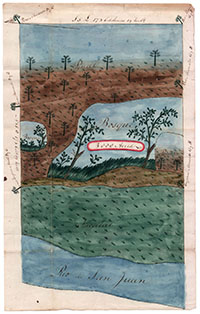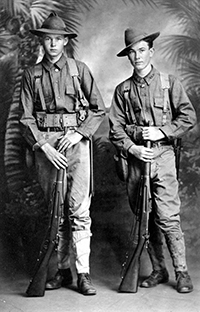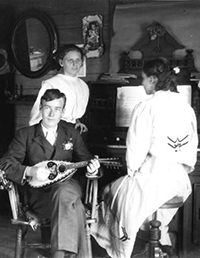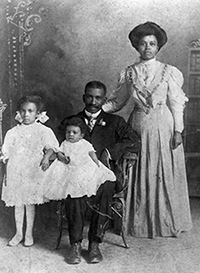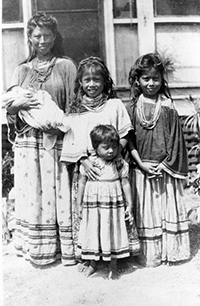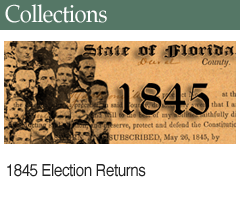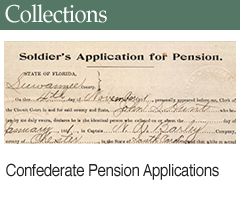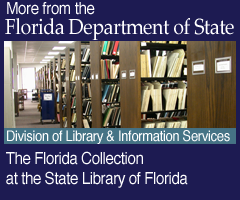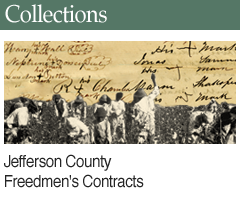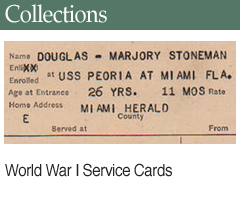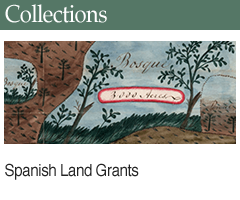A Guide to Genealogical Research
at the State Archives of Florida
Using the Collections
Many of the collections of the State Archives of Florida can be used for genealogical research. The following are among the most frequently used. When searching the collections make note of associated names, dates, places, events, and other potentially important information.
Significantly more material is available for in person research at the State Library and Archives (500 S. Bronough St., Tallahassee, FL 32399). Researchers are encouraged to visit our facility to take advantage of the wealth of resources housed in Tallahassee.
Popular Collections for Genealogical Research
Confederate Pension Application Files
Most of the Confederate Pension Application Files contain the original application, any supplemental applications, proof of service and residency, and occasional correspondence between the applicant and the State Board of Pensions. Veteran’s applications generally include name, date and place of birth, unit dates and places of enlistment and discharge, brief description of service, wounds received, sworn statements on proof of service by comrades, War Department service abstracts, and place and length of Florida residency. Widow’s applications generally include, in addition to the above, her full name, date and place of marriage to the veteran, and date and place of the veteran’s death.
Spanish Land Grants
The Spanish Land Grants contain maps and property records related to the transfer of Florida from Spain to the United States in 1821. The Board of Land Commissioners was established in 1822 to settle all outstanding Spanish land grant claims in the territory. The Board set up offices in Pensacola and St. Augustine to ascertain the validity of all titles and private claims to lands in East Florida and West Florida. The Board either supported or rejected the land claims by studying the documents supplied by claimants.
The series consists of “dossiers” containing papers filed as evidence before the Board of Land Commissioners. The supporting documents include petitions or memorials to a governor for land; surveys or plats; attests; deeds of sale, gifts, wills, bequests, and exchanges; applications; and translations of Spanish documents.
Voter Registration Rolls, 1867-68
The Voter Registration Rolls, 1867-68 list individuals who registered to vote in the State of Florida in 1867 and 1868. The lists are unique in that they are the first voter rolls in Florida to systematically include African-Americans. These documents are excellent resources for historians and genealogists seeking a better understanding of Florida during the Reconstruction era. The timing of this registration period falls between federal census years, which means these records may help genealogists locate individuals who moved or died between the 1860 and 1870 censuses. The participation of African-Americans is also significant. For most black Floridians listed in the collection, this is the earliest instance of their inclusion by their full name on an official state document.
World War I Service Cards
The World War I Service Cards series consists of a card roster of Floridians who served in the United States Army during World War I from 1917 to 1919. Each soldier has one or two cards giving information on his/her military service, such as name, serial number, residence, place and date of birth, military organizations he/she served in, rank, engagements participated in, wounds or injuries received, dates serving overseas, discharge date, percentage disabled, and additional remarks.
Additional Collections
Supreme Court Records
The genealogical potential of the Supreme Court Records collection was revealed by the experience of a staff member who worked on its digitization. During the transcription of a murder case originating in Holmes County, the transcriber, a native of Calhoun County, came across several surnames shared by families in the area in which she grew up. Not everyone has relatives who left evidence of their lives in the records of Florida’s highest courts. However, if your family held property, or an interest in banking, in antebellum Florida, these collections would be a potentially fruitful place to search for nuggets on how your ancestors interacted with the legal system.
1825 Leon County Census
The 1825 Leon County Census represents the entire census return for Leon County, Florida, as enumerated by James Cameron in September 1825. Cameron recorded 996 inhabitants in the county, including 608 whites, 387 slaves, and one free person, “of Colour.”
1845 Election Returns
The 1845 Election Returns are from the election held on May 26, 1845 to choose a governor, a U.S. Congressman, and state-level representatives for the newly created state of Florida. While these documents are of considerable historical value, they are especially useful for genealogists, as they pinpoint where Florida’s voters were living at the time of the 1845 election. Depending on the circumstances, an ancestor might appear in the 1845 election returns and not in available census records, owing to having moved or died either before or after those censuses were taken.
1855 Census Returns: Marion County
The 1855 Census Returns: Marion County are the only original returns known to exist for this census. Each entry is identified by the name of the head of household, and lists the value of land and other property owned by that person. Both free and enslaved members of the household are counted, but are not named individually. Space is provided on the returns for free blacks, although only one such individual is recorded as having lived in Marion County in 1855.
Jefferson County Freedmen's Contracts
The Jefferson County Freedmen's Contracts contain handwritten agreements between landowners in Jefferson County, Florida and laborers, primarily, African-Americans, who agreed to farm the land in exchange for a share of the crop and the means necessary to live and complete their work. Generally, each contract identifies the landowner or overseer, the individuals agreeing to work the land, the kind of work to be performed, the form and amount of compensation, and any additional stipulations.
Fernandina Death & Burial Records, 1896-1916
The Fernandina Death & Burial Records, 1896-1916 contain death certificates and burial records for individuals buried in Fernandina between 1896 and 1916. The burial records are mainly for Bosque Bello Cemetery, the oldest cemetery in Fernandina. Some of the earlier records list burials in St. Peter’s Episcopal Church Cemetery and other locations. Generally, the records for each deceased person indicate the individual’s name, age, sex, race, occupation, marital status and descent. For the genealogist, these records offer documentation of persons who would otherwise be difficult to trace through public records, such as very young children and persons who frequently relocated.
Photographs
Finding ancestors in the Florida Photographic Collection can offer details beyond physical appearance. Details and contextual information about their lives can be gathered from clothing, location, and other details, such as buildings or vehicles, in the photographs. A family group photograph may also help to pinpoint family members in a specific point in time, for example if grandparents were present and how many children there were.
WPA Church Records
The WPA Church Records contain church surveys collected by the Works Progress Administration’s Historical Records Survey in the 1930s and 1940s. Each state created a list of known churches and synagogues to be surveyed, organized by county. Survey workers then ventured out into the field to document church histories and record holdings by interviewing clergy and congregation members. This collection contains the documents created by the state of Florida.
The form used by field workers for the Church Archives Inventory, titled "Form 20HR," included fields for church name (or names), address, name of the pastor, architectural and building details, race and size of the congregation, location of church records, and additional information deemed relevant.
Folklife Collection
The Florida Folklife Collection contains thousands of photographs, sound recordings, and research materials collected by state folklorists from the 1970s to the present. The genealogical potential in this collection is twofold. First, researchers can use the collection to find resources on family members who participated in the Florida Folk Festival, or any of the field surveys conducted by state folklorists over the past half century. Second, because the collection touches on a wide variety of topics, researchers can find contextual information on activities or occupations practiced by their ancestors. For example, if your family worked in commercial fishing, you could consult several hours of interviews with fishermen across the state to better understand the rhythms of life in the seafood industry.
Timeline
The Timeline provides context for Library and Archives collections within Florida history, and can be a starting point for further research.
Topical Guides for Further Research:
Tips for Getting Started with Genealogical Research
- BEGIN WITH YOURSELF - start listing all the information you know, such as; your full name, date of birth, and other important dates, and the full names of your parents and grandparents, if known. Start writing for birth, death, and marriage certificates.
- LOOK THROUGH THE RECORDS THAT YOU HAVE AT HOME - family Bibles, original certificates, newspaper clippings, diaries, letters, school yearbooks, and photographs, are just some of the many sources of family information.
- TALK TO THE OLDER MEMBERS OF YOUR FAMILY - be sure to write down what they tell you. Write to family members, share your information with them, and encourage them to become interested in your family history — make it a family project!
- GET ORGANIZED - right from the beginning, write down all the information you find using a proper citation form. Start a filing system so that you can easily locate the information again when you need it and to avoid searching the same records more than once. Family charts and group sheets are available from many sources, including FamilySearch. Genealogy programs, such as Personal Ancestral File or Family Tree Maker, can be extremely useful in organizing and recording your research.
- BE SYSTEMATIC - work from the known to the unknown; do not skip generations.
- KNOW WHAT YOU ARE LOOKING FOR - decide on which branch of your family you are going to begin researching; then make a list of the information that you need to locate.
- DATES ARE VITAL TO GENEALOGICAL RESEARCH - check every source possible, including: federal census records; pension records; church records; cemetery records; and local and state records.
- KNOW THE HISTORY AND GEOGRAPHY OF THE AREA YOU ARE RESEARCHING - knowledge of history, and of migration trails, is a valuable aid to you in your research. Local and state maps are also important tools.
- JOIN AND SUPPORT YOUR LOCAL AND STATE GENEALOGICAL SOCIETIES - read genealogical journals and increase your knowledge of genealogy by serving on the various genealogical committees and networking with other researchers.
- SUPPORT YOUR STATEWIDE ARCHIVAL PROGRAMS - become active in local, county and state historical records boards. If records are important to you, let your elected officials know of your concern for their preservation and use. Join the Friends organization in your area, and volunteer your time and talents.
Useful Free Internet Sites
- Cyndi’s List of Genealogical Sites on the Internet
- FamilySearch — Family History and Genealogy Records
- Find A Grave
- Florida Bureau of Survey and Mapping —General Land Office Early Records
- Genforum
- Google Books
- Library of Congress — Historic American Newspapers
- National Park Service — Civil War Soldiers and Sailors System
- PALMM - Florida Militia Muster Rolls — Seminole Wars
- Rootsweb
- U.S. Bureau of Land Management — General Land Office Records
- U.S. Department of the Interior — Trace Indian Ancestry
- U.S. Genweb Archives

 Listen: The World Program
Listen: The World Program